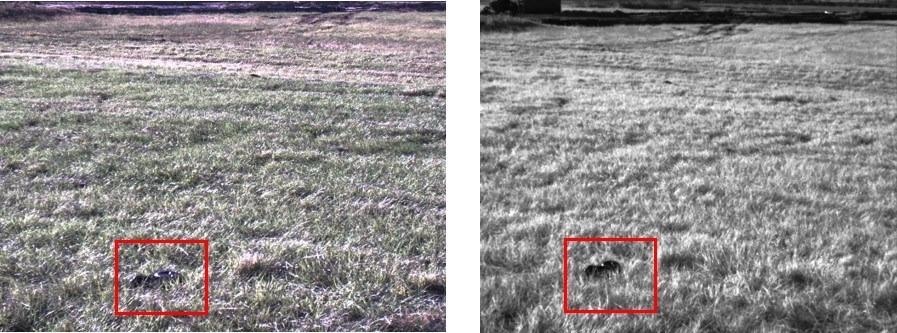Jun 8 2021
For over 25 years, Burmese pythons have been thriving and breeding in the Florida Everglades where they feed on native wildlife and disturb the delicate ecosystems of the region.
 A new study shows that infrared cameras could make it easier to spot invasive Burmese pythons in Florida. Compared to an RGB visible image (left), the near-infrared image (right) helps the snakes stand out in the grass. Image Credit: Jennifer Hewitt, University of Central Florida College of Optics and Photonics.
A new study shows that infrared cameras could make it easier to spot invasive Burmese pythons in Florida. Compared to an RGB visible image (left), the near-infrared image (right) helps the snakes stand out in the grass. Image Credit: Jennifer Hewitt, University of Central Florida College of Optics and Photonics.
A new study has now demonstrated that infrared cameras could make it easier to detect these intrusive snakes in the Florida foliage, offering a new way to help eliminate these creatures.
In the Optical Society (OSA) journal Applied Optics, researchers headed by Dr Kyle Renshaw from the University of Central Florida College of Optics and Photonics have reported that a near-infrared camera allowed people to spot Burmese pythons at distances of up to 1.3 times farther than was possible with a conventional visible-wavelength camera.
Since infrared sensors are compact and affordable, they could be effortlessly integrated into vehicle-mounted or handheld systems developed for detecting pythons.
The removal of Burmese Pythons is vital to preventing further damage to the Floridian ecosystem and preventing their spread to other regions. Our study—one of the first to examine the efficacy of near infrared sensing in locating these pythons—can help inform methods used to remove them from the environment.
Jennifer Hewitt, Study Lead Author and PhD Student, College of Optics and Photonics, University of Central Florida
Making Snakes Stand out
Burmese pythons can measure up to 20 feet in length and weigh around 200 pounds. They arrived in the United States as exotic pets in the 1980s but these creatures proliferated in the Everglades when a breeding facility was destroyed during Hurricane Andrew that occurred in 1992.
The natural camouflage of pythons allows them to easily merge with foliage and grass, thus making them difficult to detect with a conventional visible-light camera for the human eye. In an earlier study, the researchers quantified the reflectivity spectra of Burmese pythons in the infrared and visible wavelengths and observed that pythons are more noticeable against the background at longer than 750 nm infrared wavelengths.
Based on these earlier findings, we hypothesized that using near-infrared wavelengths for imaging could make the pythons easier to see because they would appear dark against bright foliage. Although we haven’t acquired reflectivity measurements from other species of snakes, the pythons should be easy to distinguish since they are larger than any other native species of snake.
Jennifer Hewitt, Study Lead Author and PhD Student, College of Optics and Photonics, University of Central Florida
To check their theory, the researchers captured pictures of Burmese pythons in the grass using infrared and visible cameras with analogous fields of resolution and view. They subsequently asked volunteers to look at these images and indicate whether they could see a python. Depending on the volunteers’ responses, the researchers estimated the benefit of utilizing near-infrared images as opposed to visible ones.
The method we used to evaluate each of the sensors was originally established for military sensing applications. It accounts for the attributes of human vision and perception in addition to the characteristics of the system components to determine how effective a system is at allowing the observer to accomplish a task.
Jennifer Hewitt, Study Lead Author and PhD Student, College of Optics and Photonics, University of Central Florida
Spotting Pythons Day or Night
While other studies have investigated using thermal infrared sensors to detect Burmese pythons, these reptiles had to be basking in the sun during the day in order to be detected at night. Moreover, the thermal contrast against the snakes’ environment decreased over time.
“In this work, we don’t rely on thermal contrast. We found that near-infrared imaging can be used both during the day as well as at night with illumination to improve detection, even if the pythons have not been basking,” added Hewitt.
The investigators got in touch with the Florida Fish and Wildlife Conservation Commission (FWC) to work on a study that extends these findings.
“We are evaluating whether or not this technology will be effective in the field, and, if so, how to make it field-ready in the challenging Florida everglades ecosystem. We are just in the beginning stages of our project with the researchers,” concluded McKayla Spencer, the FWC interagency python management coordinator.
Journal Reference:
Hewitt, J., et al. (2021) Detection of Burmese pythons in the near-infrared versus visible band. Applied Optics. doi.org/10.1364/AO.419320.